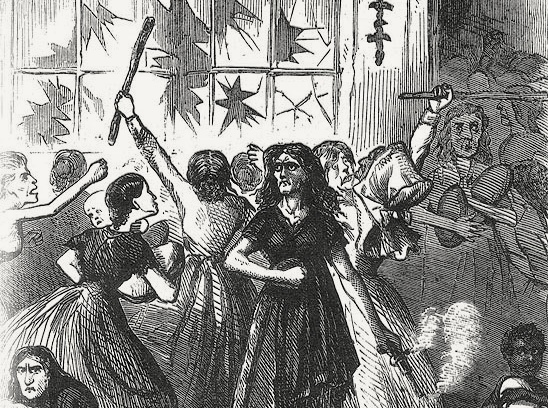Civil War: The Bread Riot
This week in 1863 a group of women gathered at the Capitol to protest the lack of food in Richmond–things quickly turned violent.

If you were to ask Richmonders about riots in our city, they might tell you that most of them are VCU basketball related.1 And let’s be honest, even those are pretty tame–both by modern and Civil War era standards.
One of Richmond’s most famous riots occurred on April 2, 1863, and it had nothing to do with VCU reaching the Final Four. It was a lot simpler than that…it was about bread. I’ve talked before about the challenges of living in the city during the war, but it bears repeating. Due to the Union blockade, resources needed for soldiers, and other wartime challenges, food was both hard to come by and much more expensive than before the war. Food prices in Richmond were ten times higher in 1863 than they were in 1861. Many Richmonders struggled to afford even the most basic provisions. Adding to the problem was a healthy market of speculators and unethical merchants who hoarded supplies and food in order to sell it at exorbitant prices.
From the Richmond Dispatch:
Bread was scarce and high. Meat was a luxury. Coffee and sugar had long since disappeared from the tables of the poor. Most of the able-bodied men were in the army, but the population was largely increased as the city was filled with refugee country people, many of whom left their homes in the night-time and empty-handed and fled to Richmond to escape the enemy’s raiders and marauders. There was great suffering. Richmond Dispatch, 1/20/1889
On April 1st, a group of women gathered in Oregon Hill at Belvidere Hill Baptist Church to discuss the food shortages and the high prices. They were a mixed lot–some were laborers in the C.S. Laboratory on Brown’s Island, some were wives of Tredegar workers, others had husbands and sons fighting the war. Together they resolved to go to the Capitol the following day to meet with Gov. John Letcher and demand something be done.
The next day, the women headed to the governor’s mansion to get an audience with Letcher. Accounts differ on what happened next: either the women weren’t able to meet with Letcher, or they spoke to him briefly, and he dismissed them. The women then gathered around the statue of George Washington in Capitol Square and began to protest. As the protest continued, the crowd continued to grow with onlookers and additional protesters. They soon left Capitol Square and headed down Main Street towards Shockoe Bottom. The desperation and anger of the protesters soon turned to violence as they smashed windows and looted stores and businesses for food and other goods. The mayor came out to read them the riot act, but was ignored.
In order to stop the looting, soldiers from the Public Guard were called up. Both Gov. John Letcher and President Jefferson Davis also arrived on the scene. There are mixed accounts of what was said, but both men addressed the unruly crowd. Davis pleaded with the rioters to return to their homes and threw all the money in his pockets into the audience, saying it was all he had to give. Next, either Davis or Letcher ordered that the crowd of protesters disperse in five minutes or the soldiers would be given the order to fire upon them. After a few tense moments, the crowd left the streets and returned to their homes. There would be no further violence.
Even though the incident only lasted two hours, the Confederate government quickly realized the PR problem they had on their hands. They quickly tried to squelch the story, instructing local telegraph operators “…that you will permit nothing relative to the unfortunate disturbance which occurred in the city to-day to be sent over the telegraph lines in any direction for any purpose.”
They worried that news of bread riots would reach the Union press and their shortages of food and other supplies would show Confederate weakness. Despite their best efforts, word spread to the North, and the bread riot story made the front page of the New York Times on April 8th.
Several of the protesters were tried and arrested in the weeks following the incident, including their ringleader Mary Jackson. Some newspapers speculated that the riot was planned by Northern insurgents, but it’s clear that this incident was the result of the systemic problems of inflation and food shortages in the city. Later that year, several Southern cities would stage bread riots of their own.
Richmond’s bread riot encouraged leaders to take more steps to help the city’s poor, but the city would continue to suffer from food shortages for the duration of the war.
— ∮∮∮ —
Footnotes
- Just to be clear, I’m using the “riot” reference jokingly. VCU students celebrating in the street after a basketball game is a good thing in my book. Go Rams, etc. ↩
-
Recommend this
on Facebook -

Report an error
-

Subscribe to our
Weekly Digest




Notice: Comments that are not conducive to an interesting and thoughtful conversation may be removed at the editor’s discretion.
From Harry Kollatz:
The Richmond Examiner doesn’t think too highly of the women who engaged in the Richmond Bread Riot. Here’s the sneering editorial day-after assessment. http://www.mdgorman.com/Written_Accounts/Examiner/1863/richmond_examiner_441863f.htm
More:
http://www.mdgorman.com/Written_Accounts/Dispatch/Postwar/richmond_dispatch_12301888.htm
Rioting is what’s going to happen when all of the able-bodied white males have gone to war and the starving people left behind have no legal right to vote (1920’s) , own property (1900’s) or they were the actual property (greasy ways around that in the South existed until the 1940’s through “debt peonage”).